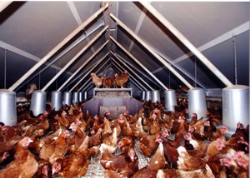
House design is likely to have a big influence on bird welfare if free-range layers or table birds have to be confined as a defence against bird flu, says Roger Smith of Staffordshire-based ARM Buildings.
Paddock-based houses rely on natural ventilation and the greatest problems are likely to occur in poorly-insulated buildings in warm weather since these can suffer from raised temperatures as a result of solar gain.
"Some houses have single-skin roofs and on sunny days these allow heat from the sun's rays to penetrate inside. If they are totally closed and have no ventilation outlets in the ridge then the temperature rise can be considerable," he points out.
Pitched-roof buildings which are fully insulated and allow air in through the pop-holes and out through vents in the ridge work best. The insulation prevents any unnecessary solar gain while the 'stack effect' ensures that hot air generated by the birds themselves rises to outlets in the ridge, aided by the roof slope.
Those that rely on inlets and outlets on the side-walls need a wind to work and are likely to cause problems on still days, warns Mr Smith. In such building some form of mechanical ventilation may need to be considered.
He reminds producers that if they are required to keep birds inside then all apertures need to be netted with 25mm mesh to keep out wild birds and if home-made verandahs are added to the building then they too need solid roofs, otherwise wild-bird droppings could fall through the netting causing potential problems from contamination.
